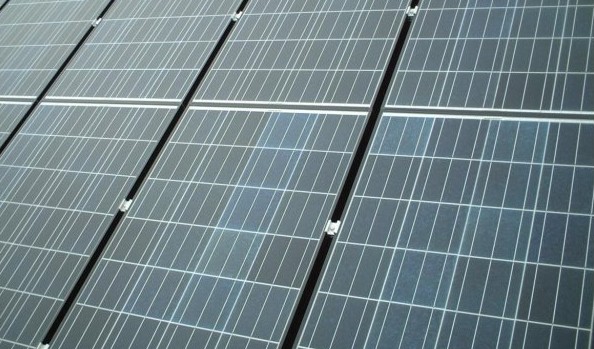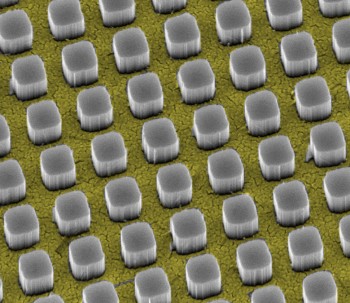
Researchers develop ‘invisible’ solar cell wires, could boost panel efficiency 20 per cent
by Cleantech Canada Staff

Design uses "silicon nanopillars" to hide wires that generally cover five to 10 per cent of a solar cell's surface

A conventional solar panel, its “contacts” seen in a grid formation throughout. PHOTO: Mhassan abdollahi, via Wikimedia Commons
STANFORD, Calif.—Researchers at Stanford University have developed what could be a significant step forward in solar cell technology.
Typical solar cells use a grid of “contact” wires to collect the electric current generated by the rest of the panel. While the metal contacts are excellent at conducting electricity, they have one major drawback: they also reflect incoming sunlight away from the panel.
The California university’s team of scientists, however, may have found a solution.
“Using nanotechnology, we have developed a novel way to make the upper metal contact nearly invisible to incoming light,” the study’s lead author, Vijay Narasimhan, who conducted the work as a graduate student at Stanford, said in a statement. “Our new technique could significantly improve the efficiency and thereby lower the cost of solar cells.”
Metallic wires generally cover five to 10 per cent of a solar panel’s surface, resulting in significant energy loss.
“The more metal you have on the surface, the more light you block,” the study’s co-author and associate professor of materials science and engineering, Yi Cui, said. “That light is then lost and cannot be converted to electricity.”
To tackle the problem, the researchers wrapped the contact metal in 16-nanometer-thick gold film that was then placed on a sheet of silicon. Normally the gold film would reflect as much as 50 per cent of the incoming sunlight. The scientists, however, riddled the film with microscopic square holes. To eliminate more of its reflective properties, they then immersed it a solution hydrofluoric acid and hydrogen peroxide.
“The gold film immediately began sinking into the silicon substrate, and silicon nanopillars began popping up through the holes in the film,” another of the study’s author’s, Thomas Hymel, said.
The silicon nanopillars growing out of the gold film altered the film from a reflective gold to a dark red, something the researchers noted was a “clear indication” the metal was no longer reflecting light.
“As soon as the silicon nanopillars began to emerge, they started funneling light around the metal grid and into the silicon substrate underneath,” Narasimhan said.
The researcher compared the nanopillar array to a kitchen colander.
“When you turn on the faucet, not all of the water makes it through the holes in the colander,” he said. “But if you were to put a tiny funnel on top of each hole, most of the water would flow straight through with no problem. That’s essentially what our structure does: The nanopillars act as funnels that capture light and guide it into the silicon substrate through the holes in the metal grid.”
Through a series of simulations and experiments, the team then optimized the design. They said the technology could boost the efficiency of a conventional solar cell from 20 percent to 22 percent. According to the researchers, the nanopillar architecture will also work with contacts made of silver, platinum, nickel and other metals, something that will be vital in bringing down the cost of the potential new technology.
The research team now plans to test the design in real-world conditions.
Watch how scientists developed the innovative wires:
